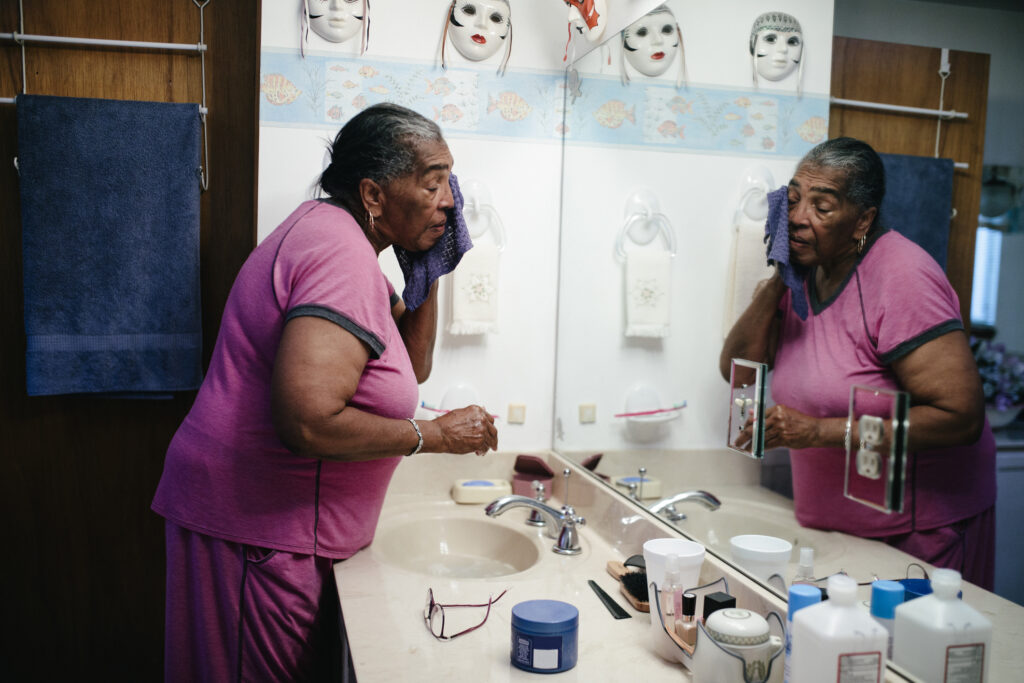
We use washcloths everyday. Well, most of us do according to a recent poll. But are you doing damage to your skin every time you use one? Well it depends on what kind of washcloth you use. Take a look below at the ones you should avoid and others you should keep around.
Worse Washcloth: Terrycloth
Most folks are familiar with the plain-old terry cloth washcloths, the ones you may have stolen from your mother’s linen closet before moving out. Yes, you need a new one. Why? Because the more you wash cotton, the more brittle it becomes.
You might feel like you’re exfoliating all your troubles away with that old-school terrycloth washcloth, but it’s too easy to over-scrub when you use those soft (seeming) cloths. Then, you’re not exfoliating, you’re creating tiny tears in your skin, which can lead to inflammation and wrinkles. Oh, and those washcloths are havens for bacteria. Think about it: you wash your face, (kinda) rinse and wring the washcloth out, then let it air dry until you use it again. There are dead skin cells on that washcloth. There’s ample opportunity and time for bacteria and other microbes to grow and spread.
Worst Washcloth: Anything static resistant, stain resistant, permanent press, wrinkle-free, stain proof or moth repellant
Many of the stain-resistant and wrinkle-free fabrics are treated with perfluorinated chemicals (PFCs), like Teflon. Many – not all – synthetic fibers, do not absorb water or regulate temperature. This barrier effect may also create conditions of bacterial growth that could result in skin disorders.
Worst Washcloth: Dollar Store Loofa
Technically, it’s not a washcloth, but many of us still use it. Loofahs are hygienic to start out with, but it’s how they are maintained that will affect their longevity.
Your loofah scrubs dead skin cells off of your body, which get caught in all of the nooks and crannies of the fibrous matrix of the loofah. When you’re done scrubbing, chances are you leave the loofah in the bathroom until its next use. This is the opportune moment for bacteria to cultivate. The shower environment is a nice, humid environment — there’s not a lot of air circulation, and it’s a great place for bacteria to hang out. The bacteria eat any organic matter — like those discarded skin cells — left behind in the loofah.
MUST SEE: How Many Washcloths You Should Keep In The Shower
Every time the loofah gets wet and does not dry properly, the organisms grow and grow. You spread the bacteria that you washed off your body the last time — yuck!
Now that you know the worst washcloths, here are three of the best:
Best Washcloth:Aquis Essentials Exfoliating Wash Cloth
Rougher than your average washcloth fare, this cloth falls into the “not-every-day’ category. We know it’s bad to over-exfoliate, so Aquis has dual-textured technology that keeps the experience from being too coarse (that’s a fancy way of saying there’s a scratchy side and a not-so-scratchy side).
Best Washcloth: Bamboosa Adult Washcloths
Even though the name says “adult”, it’s definitely as soft as a baby’s bottom. Which doesn’t mean you can’t use it to feel baby soft as well. Everyone could use something lightweight and gentle every now and again.
Best Washcloth: Fairface Washcloths
This washcloth is rugged and soft all at the same time (imagine a strong teddy bear). And yes, it is just as good as it sounds. It’s silky-soft and manages to get better with frequent washing. Hunky Brooklynite not included.
When Should Washcloths Be Changed?
Towels that are used on a regular basis to dry our face and body and keep them clean will start to accumulate the dirt sooner or later from that continuous use. Overusing towels could do more harm and beats their purpose.
Face towels should be changed at least every other day or more often than you need since they accumulate different substances from drying your face. Remember that washcloths wipe dirt, skin oil, facial wash, shaving foam, make-up, toothpaste and other residues that could wear down your towel.
Hand towels are used more frequently and commonly in kitchens, therefore, more people are using the same hand towel compared to a single face towel. This means that hand towels get dirtier and faster.
Ideally, you will have to purchase more face towels than hand towels and stock them up in your bathroom. Hand towels should be washed or changed every two days.
Why Face Towels Requires More Care
Dirty towels can be a breeding ground for odor-causing and dangerous bacteria. They are thicker than usual fabrics so they can absorb more moisture—an environment where bacteria thrive.
Would you want to wipe your face with a smelly, bacteria-infested towel?
Face towels are used for one of the most sensitive parts of the skin—your face. It’s only logical that they are replaced more frequently and thoroughly cleaned.
Hand towels, on the other hand, should be changed or washed every one or two days since we used them more frequently. Always follow the washing instructions to avoid damaging your rowels.
You should wash your towels alone and avoid mixing them with your other laundry. You could also add vinegar in place of fabric conditioner.
It is also advisable that we separate towels according to their fabric to avoid wear and tear for softer fabrics.
Airdrying will keep them fresh and soft for a longer time. Make sure you store them in clean and dry cabinets. Proper storage furthe
Are disposable towels safe for the environment?
The simple answer is it depends. Not all disposable face towels are created equally. When looking for new face towels to add to your skincare routine, make sure to do your research beforehand to ensure they are biodegradable or otherwise environmentally friendly. New York City board-certified dermatologist and founder of OptiSkin, Dr. Markowitz elaborates on the environmental implications of adding disposable face towels into your skincare routine.
“While in general disposable facial towels may feel soft and gentle and they don’t carry the same bacteria that comes with daily use of a regular towel, they are awful for the environment. Because you can throw out a disposable towel after one use, there is no worry about cross-contamination, odors, or bacteria growth. If you are using disposable makeup wipes or cleansing cloths, the same applies. Not only are they bad for the environment, but they contain chemicals that could impact our skin’s natural biome. ”
And if you really want to know how to take care of your skin with oils, lotions and cloths, click here.









